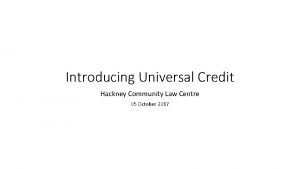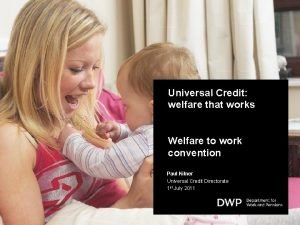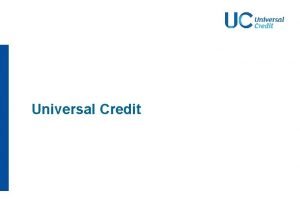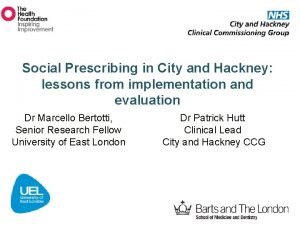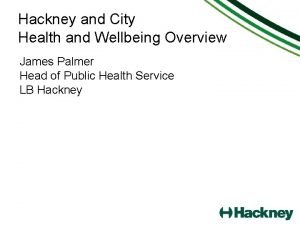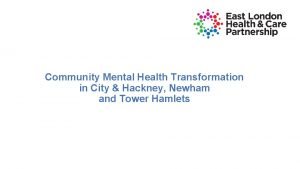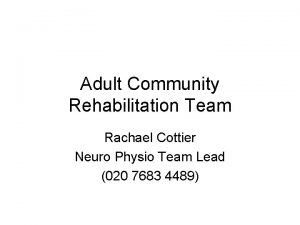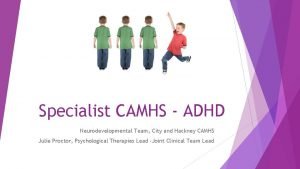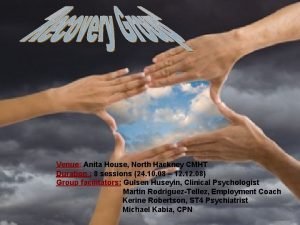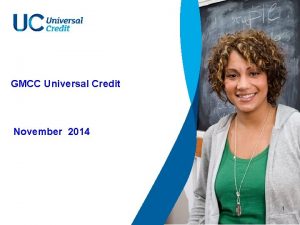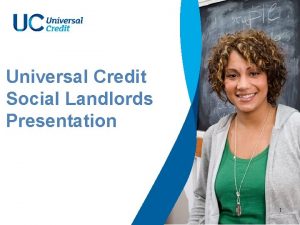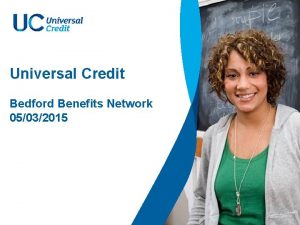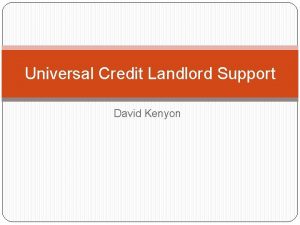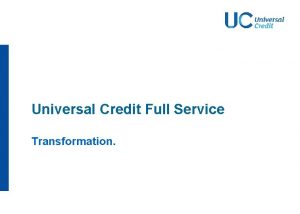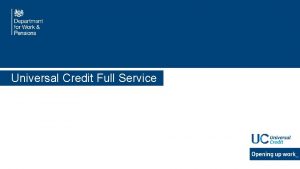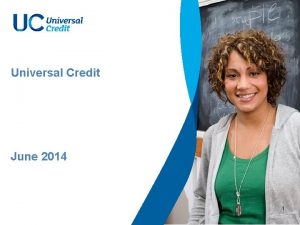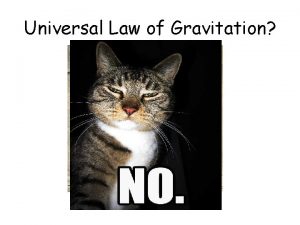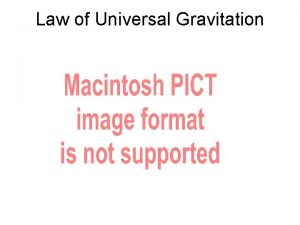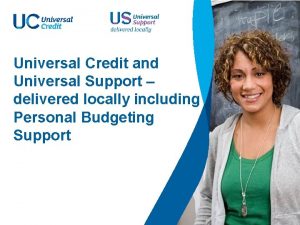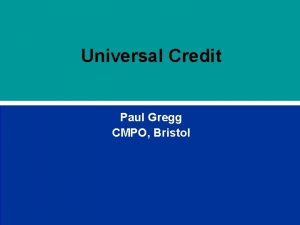Introducing Universal Credit Hackney Community Law Centre 05


















- Slides: 18

Introducing Universal Credit Hackney Community Law Centre 05 October 2017

Objectives of this course include • Introduction to the changes brought by Universal Credit • How to claim • Calculating Universal Credit entitlement • Structure of the claim • The relevant legislation • The impact on different types of claimants • Sanctions and how these apply • Future changes

Universal Credit – what’s new? • • • Attempt to simplify the current claims and reporting system; Brings in many new changes to reduce costs to the public purse; Is non-contributory based and means-tested; Is subject to residence requirements; Will eventually replace tax credits; Payments will be within assessment periods; No paper claims – but exceptions apply; Backdating will be limited to one month and is discretionary; HB, contributory ESA/JSA remain;

Working it out 1 • Standard allowance (according to age and status i. e. single /couple) • The elements (add all that apply) • Deduct the income (earned or unearned); • Apply the taper • Are there any disregards? • Does the benefit cap apply?

Working it all out 2 • • Standard allowance Child element Disabled child element Childcare costs element Housing costs element / owner occupiers / housing costs contributions Carer element Limited Capability for work (and work-related activity) element

Working it all out 3 – the deductions • The ‘unearned’ income – what’s this? contributory –ESA; contributions-based JSA; maternity allowance, SSP, student income / loans and is deducted pound for pound earned. No taper applies. • The earned income Remuneration from profits earned from employment, trade, profession or vocation. Taper of 63% is applied – check for disregards. Employers should be using Real-Time Information system to inform HMRC of claimants’ earnings. • Self employment p. 22 Includes ‘gross profits’ less Class 2 and 4 Contributions, pension scheme payments etc. Gross profits are actual receipts in any period. Has the claimant complied with the eligibility criteria. A minimum income floor will be applied to low earners.

Self-employed earners • Tough scrutiny tests brought in to determine if earner is in genuine and effective work. • Income is that from any trade, profession or vocation. • Gross profits will be earnings less, Class 2 and 4 contributions, pension scheme payments, income tax. • Start-up periods apply to this group so minimum income floor does not apply for up to 12 months. • Minimum income floor = 35 hours x NMW /Living wage rates. • Is the self-employed genuinely accounting for all income earned?

Universal Credit – Claimant Commitment • A document containing what the claimant has committed to in order to receive UC. For couples both parties have to commit. • Time limits apply to the commitment • Work coach and claimant agree – limitations could be applied by either party. The DWP has discretion as to content. • Exceptions for those without capacity to commit. • Work-related requirements will hit able-bodied hardest. • The four categories of claimants. • The ‘earnings threshold’ for those already in work or has good work history. • Recently been dismissed or voluntarily left work.

Sanctions – Reg. 100 Universal Credit Regs. • Will apply where DWP believe they should. Will depend on whether failure is for the first, second or third time. • Group 4 claimants will be hardest hit – with sanctions applying from a basic 91 days up to 3 years • Failures could include – failure to meet work target applications; not complying with work-related requirements, using Universal Jobmatch, late for interviews, being dismissed and could affect new claimants to UC who previously gave up work. • Was claimant on a course of study or ‘receiving education’? • Is the claimant appealing a dismissal that was unfair? Are they in touch with ACAS? Was there trade union involvement?

Sanctions • Medium level 28 – 91 days and would most likely apply to Group 4 claimants again. • Low level – Group 3 and 4 claimants – some of those already in work could be expected to do more to get better paid work or more hours. • Lowest level – Group 2 – those required to attend work-focused interviews only. Their sanctions will hit 40% of the standard allowance and will cease when the claimant contacts Jobcentre by way of preparing to engage.

How much is the loss? Under 25 s High Rate Per day Low rate per day Single person £ 8. 20 £ 3. 30 Couples £ 6. 40 £ 2. 50 Single £ 10. 40 £ 4. 10 Couples £ 8. 20 £ 3. 20 25 and over

What help is available after a sanction? • Hardship payments – establish a genuine need for the additional payments. There must be an acceptance that this has to be repaid. • DWP may direct claimant to other resources, i. e. other benefits or family members; • Hardship payments are for basic essentials only! • There are limits to these payments. • DWP may also request compliance with work-related requirements before payments are made. • A sanction will terminate where a claimant starts work; • The low rate of 40% applies to sanctions in some circumstances – p. 17

Appeal • The usual structure will apply. • Identify the decision and when it was made. • Decisions should be communicated in writing to the claimant /appointee / proxy etc. • Request a Mandatory Reconsideration (within one month). There was a successful challenge to the standard 28 -day rule in July 2017. DWP to comment on this. • If unsuccessful, then the next stage is to ask an independent tribunal to review via form SSCS 1 – can be downloaded from Google. • Backdate requests will need to meet a high standard before they are granted. Hospital discharge letters etc.

Universal Credit What stays – list not complete • • • What’s going / gone Attendance Allowance – PIP / DLA • Income Support Carer’s Allowance • Income based JSA Child Benefit • Income-related ESA Contribution-based JSA Contributory ESA Industrial Injuries Maternity Allowance Pension Credit Statutory maternity / paternity pay Statutory Sick Pay • Housing Benefit • Child and working tax credits • Severe disability premium • Enhanced disability premium

Who qualifies? • Claimants must (ideally) be at least 18 – exceptions apply • Should be under Pension Credit age – check mixed couples • Living in Great Britain • Should not be ‘receiving education’ • Signed up to the claimant commitment. • Single and / or joint claimants whose income / capital is under £ 16 K

The exceptions that apply to claimants 16 / 17 year olds can claim – p. 21 Students can claim if not in ‘advanced education’ Self-employed earners (presumption of the minimum income floor) Persons from abroad who establish a permanent right to reside or are ‘habitually resident’, if claimant is a couple then both need HTR • Vulnerable people – cannot use a computer/ will need alternative payment arrangements • •

Benefit Cap exempt households • Household receiving DLA, PIP or AA (or a child getting DLA / PIP) • In receipt of Industrial Injuries Benefit • Receiving a war pension • Carer’s Allowance or carer element in UC • Guardian’s Allowance • The income is at least £ 430. 00 net per month (exempt from workrelated requirements under UC) • DHP could help to reduce shortfall with rent.

The stark changes • Housing costs – the intention is that owner-occupiers can apply for a loan towards their ongoing mortgage interests which can be repaid from a sale of their home or recouped via instalments when the claimant returns to work • No entitlement to housing costs for 18 – 21 year olds unless certain exemptions apply to them. • LCW is now gone for new claimants to ESA from April 2017. Eventually, the persons receiving LCW who transfer to UC will either have to move on to LCWRA after further assessments. • Child element of UC will be limited to families with two children and those with third or subsequent births after 6 April 2017 will get no child element. Disabled child element and child care costs will not be affected. • The higher child element for first born children will be phased out. • Transitional protection will apply to those claimants who are moved over to UC not to new claimants or those transferring after a change of circumstances. • There are plans that could affect those in receipt of free school meals, cold weather payments, social fund maternity or funeral payments in the future.
 Hackney community law centre
Hackney community law centre Department of work and pensions
Department of work and pensions Universal credit assessment period
Universal credit assessment period Universal credit and prescriptions
Universal credit and prescriptions This can be avoided by giving credit where credit is due.
This can be avoided by giving credit where credit is due. Structure of counselling process
Structure of counselling process Social prescribing hackney
Social prescribing hackney Hackney population density
Hackney population density City and hackney recovery college
City and hackney recovery college Paradoc hackney
Paradoc hackney Hackney autism service
Hackney autism service Acrt hackney
Acrt hackney Hackney adhd clinic
Hackney adhd clinic North hackney cmht
North hackney cmht New jersey space grant consortium
New jersey space grant consortium Center for excellence in universal design
Center for excellence in universal design Centroid engineering mechanics
Centroid engineering mechanics Cg of hemisphere
Cg of hemisphere Newton's first law and second law and third law
Newton's first law and second law and third law
